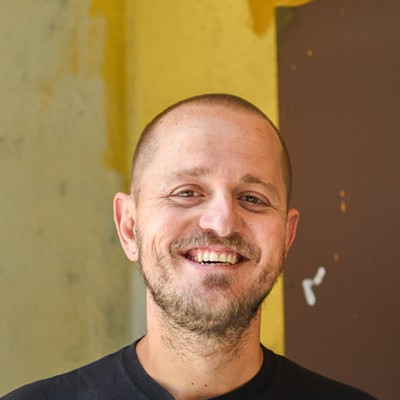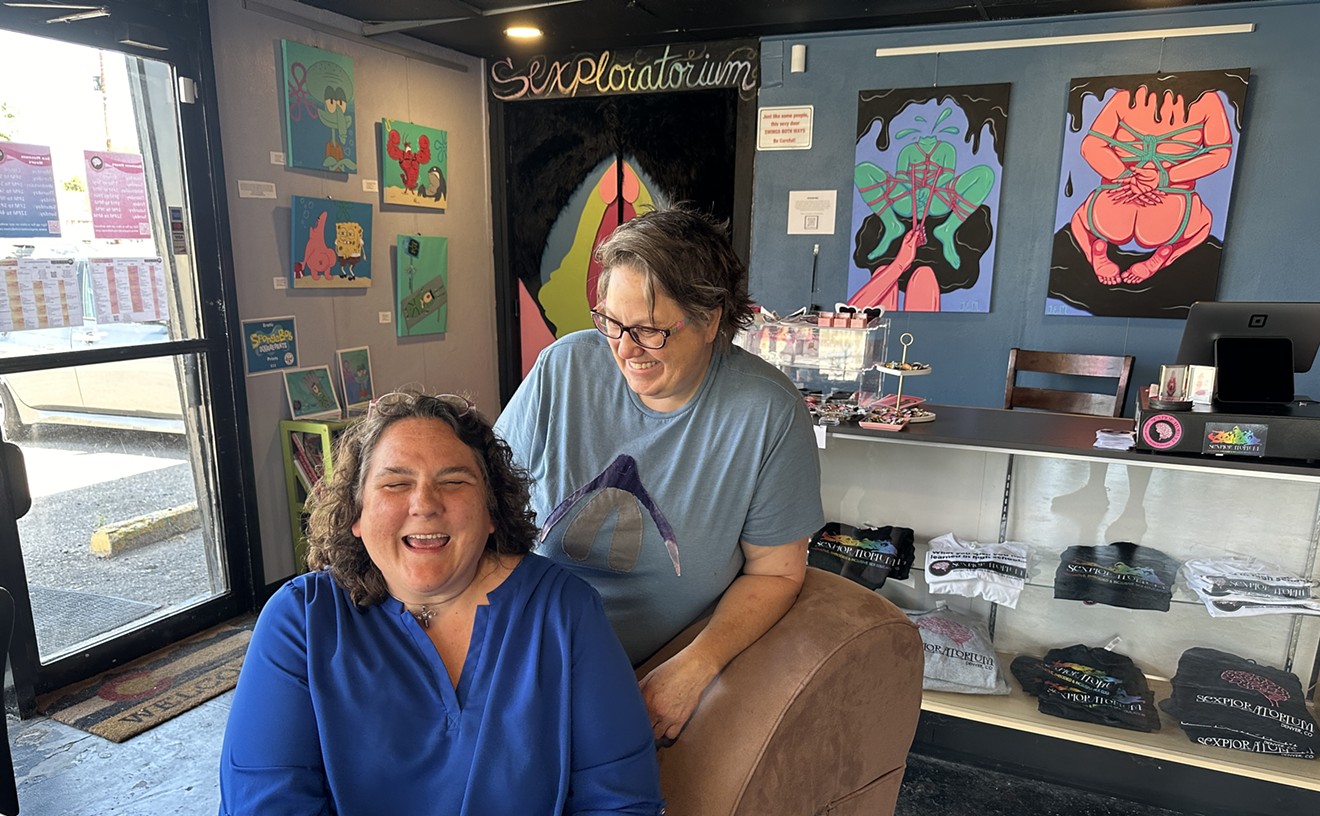In an old Salvation Army warehouse in Globeville, Denver DJ-turned-aspiring-filmmaker Musa Bailey has penned two words on a whiteboard: “Black Dads.”
The warehouse, near the I-25 and I-70 interchange, was purchased in 2020 by developers Ken Wolf and Ari Stutz. But construction on their proposed project is years away, and the developers, both backers of the arts, worked out a deal so that Musa and his seven-year-old son, Glen, could use the building while they shoot a samurai-themed, hip-hop stop-motion animation about Black fatherhood called Assassin With Son.
Musa and Glen are making a glorious mess of the space, which they work in all day long, every day. Half-clothed action figures murder each other, frozen in the act on a table littered with ninja costumes and tools. Prints of samurai warriors and Halloween and KKK hoods hang next to photos of Musa and Glen. Monitors, a laptop loaded with animation software, speakers and a toy-sized green screen fill the center of the room.
Surrounded by it all, Glen — who cautions that he’s not as nice as he looks — gripes that his father never plays with him. Musa flinches at the accusation. While other first-graders spent the better part of the past year wearing masks, separated from each other in virtual classrooms with overtaxed teachers, Glen has been with his father, who home-schools him, nearly every hour of every day. Part of their time has been spent turning this massive room, with jazz playing softly on a boombox, into an animation studio where the two create together nonstop.
When he’s not dressing up dolls in bizarre outfits and staging their gruesome deaths, Glen is breathlessly spitballing the movie’s plot. Musa and Glen will be depicted as samurai warriors fighting against evil, Klan-like ninjas who represent racism, economic violence and all of the other ills confronting Black fathers and sons in the United States.
But it’s not race, or Japanese culture, or even his dad that Glen’s wide-eyed about today. It’s a bad guy named Shogun and how he will transform into a monster.
“I've got an amazing idea,” shouts Glen to his father, hardly pausing between words. “So when Shogun turns into a demon, his house turns into coals and then the floors melt off.”
“Come on, man,” Musa says with a grin. “I gotta start writing this stuff down, bro.”
“And then...the little part where the chimney part comes out...out of there comes out fire,” Glen continues.
“Lots of fire, for sure,” his father replies.
“I’ve got the best idea,” Glen interrupts. “It’s pouring lava and fire and gas coming out of the chimney top when he turns into a demon.”
This goes on for half an hour until Musa begs Glen to let them take a break for lunch.
Before embarking on this filmmaking journey, Musa set out on a different, pandemic-related project: binge-watching all nine seasons of Seinfeld when he wasn’t teaching Glen the basics of reading.
Musa — who had been at the top of his game a few years back, a club owner and grandmaster DJ humble enough to not embrace the term — wondered: “What the fuck is going on?“ He was a single dad, stuck on the couch, meeting his social needs with Jerry Seinfeld. This was not where he was supposed to be in his mid-forties.
For middle and high school, Musa attended the Kent Denver School, the private academy where his mother, who had a Ph.D. in education from Princeton University, insisted that he go. He lost himself in comic books, taught himself to deejay. Sick of all the snotty culture, he left Kent to attend Denver's Manual High, a public school. At eighteen, he had his first professional gig and started using turntables to help cultivate Denver’s hip-hop and rave scenes at warehouse parties.
His career soon blew up. He moved to New York for ten years to work as rapper and poet Saul Williams’s producer, and toured with Williams. After moving back to Denver a decade later, Musa continued to build his name. He deejayed Red Rocks, backed up members of the Wu-Tang Clan at Cervantes’, and even opened his dream club, Cold Crush, where he could perform, invite artists in to drink or party, and build community around murals, deejaying and culture.
To the chagrin of Denver’s arts community, Cold Crush, which opened in 2013, came toppling down not long after rapper Tyrone Adair Jr., aka Boss Goody, was murdered outside the club in 2016. The city deemed the business a “public nuisance,” and the landlord ultimately didn’t renew the lease, causing Musa and co-owner Brian Mathenge to move on to other things.
By now a dad, Musa was ready for change: Spinning records was a young man’s game. The late-night parties and brutal hangovers didn’t help his parenting, and Musa wanted to be there as a supportive father as Glen grew up.
So a couple of years after Cold Crush shut down, he sold his massive record collection, which was stored in his parents' garage. He took what money he had and started an Airbnb business. That proved profitable enough to keep him and his son afloat — until cancellations rolled in after COVID-19 hit. The income source that he had banked on in order to survive dried up.
Over the years, parenting had become his prime identity, and he began hashtagging himself #AssassinWithSon, documenting his journey as a father in a country designed to destroy Black men.
After watching the last Seinfeld episode, in which Jerry does standup in prison, “I felt proud of myself,” Musa recalls. “But then I was like, ‘Dude, this is not the direction you want to go down.’”
So Musa did what he had been doing since he was a middle-schooler learning to deejay: He turned to music.
He'd recorded a few beats for a project dubbed Assassin With Son, and decided to continue working on it. “Every night, I was just working on beats, working on beats, working on beats,” he recalls. “And after about two months, I remember my brother was like, ‘Dude, you haven't left your room.’ Everyone was worried about me. ‘Dude, like, what are you doing up here?'”
Two months later, he went downstairs and told his brother and business partner, Ra Bailey, that he had five new tracks, and then played them. “You have a project here,” Ra said. So they started sampling from Japanese samurai films and recorded live music from Casey Karns and Felix Ayodele, fleshing out the mixtape.
“I had a musician/producer camp in my house," Musa recalls. "People were staying in the empty Airbnb rooms, and we just recorded a bunch of music for four days straight. It was awesome. We got that done. I was like, ‘All right, this is cool.’”
But dropping another mixtape wasn’t enough. Musa had put out projects like My Robot Girlfriend and How to Survive When You're Dead, but ultimately felt like they were missing something, a visual element. For Assassin With Son, he decided to take another approach: a live-action movie.
“I was just gonna get my friends to dress up like ninjas," he recalls, "and me and Glen were gonna dress up, and then I was like, dude, that's kind of gonna look stupid, because we're not fighters. It's just gonna look like a bunch of people running around with swords.”
So he explored creating a graphic novel with Denver artist R. Alan Brooks, then decided that not only was that approach expensive, but it wouldn't be enough to do the job right — particularly since it’s hard to read a comic book and listen to music at the same time. He kept Brooks involved in the project and moved on.
He thought about puppets and started exploring his options. He looked into making a movie with marionettes, but they were too clunky to look cool fighting. Then he looked into Japanese Bunraku puppets. “It’s badass, dude. The fluidity of the puppets is dope,” Musa explains. “But it's like a centuries-year-old art, and there's no way I was going to be able to find someone who can make those and then find someone to operate them here in Colorado.
“So then I was like, all right, well, what are the other options? And then stop-motion kind of popped into my head,” he remembers, thinking back to animated Christmas specials like Rudolph the Red-Nosed Reindeer that he'd loved as a child.
Making the process accessible to Glen was a priority, and stop-motion didn’t seem so different than what the boy did with his toys every day.
“It's how Glen plays,” Musa says. “He's at the age where he gets two guys and he just smashes them into each other. But he also has whole plots and storylines and backstories and all this really cool stuff. So I was like, okay, maybe stop motion, because it would be like playing with toys.”
He first planned to use twelve-inch-tall G.I. Joes, the kind Glen already enjoyed playing with. But their limb movement was too jerky to animate, so he instead ordered articulated dolls from China that had a metal skeleton and a fleshy exterior that stayed in position consistently enough to be animated. The manufacturers even made costumes and weapons at that scale, and he was able to buy everything they needed online.
Musa, who has no filmmaking background, started studying how the stop-motion animation company Laika, which made such movies as ParaNorman and Coraline, did its work. He researched and purchased animation software and started practicing. It took him three months to figure out how to animate a fifteen-second segment. The tedious process of shooting each slight movement one frame at a time might scare most people from attempting to become animators, but Musa and Glen embraced the process.
“The plan is to make the majority of the movie with stop-motion puppets," Musa explains. While he will use some green-screen footage, he also plans to work with artists on handcrafting the sets.
“I need to build a forest,” he explains. "I need to build those old-school Star Wars sets. It's just that the puppets will look cooler in those sets than they will look in digital.”
In total, the script requires around ten handmade locations, from castles to fields.
Musa's goal is to collaborate with as many artists as possible along the way. He’s already built a team, including muralist Casey Kawaguchi; master fabricator Ryan Langan; 3-D designer Michael Sperandeo; Courtney Ozaki, co-executive producer and founder of the Japanese Arts Network; co-producer Kayvan Khalatbari; puppeteer and animator Corrina Espinosa; costume designer Holly Peterson Hurd; cinematographer Fa'al Ali; master calligrapher Kuniharu Yoshida; sound designer Chris Guillot; artist and writer Oren Lomena; and martial arts sensei Dennis King.
He launched a month-long Kickstarter campaign on June 1, and within two weeks had reached his $30,000 goal. This is the first time he’s tried a crowdfunding campaign, and he’s excited about the prospects.
“Look, I've been able to pay my friends to help me with this,” he says. “But it's been all out of my pocket. Balancing that and rent and bills — that's why a lot of projects don't get done. And that's why Kickstarter is so dope — because it's just for art projects. You can’t Kickstart a funeral or your homie’s sixteenth birthday. It’s only for art projects and films and comic books and stuff.”
He hopes Assassin With Son, which he guesses will run around thirty minutes, will take about a year to make, though that’s optimistic. But however long production lasts, he’s excited about trying something radically different from the deejaying world he dominated for all those years — something fresh, and something he's not an expert on.
“It's been a while since I've been eager to learn how to do something new,” Musa says. “I wake up every day and I'm reading blogs about camera angles, watching stop-motion videos on YouTube. I'm just really into this right now. It feels good. The older you get, the harder it is to find joy, you know?”
But he has.
“I can see myself doing this for the rest of my life...making stop-motion animated movies about Black people and Black experiences,” Musa says. “And they have soundtracks, and I can enter film festivals and travel and still be part of the art and music world. This allows me to do that without killing myself, without being up till four o'clock in the morning every night and being around wild times.
"This is way more conducive to Dad life," he concludes. "I’m gonna see where this story goes.”

Audio By Carbonatix
[
{
"name": "Air - MediumRectangle - Inline Content - Mobile Display Size",
"component": "12017618",
"insertPoint": "2",
"requiredCountToDisplay": "2",
"watchElement": ".fdn-content-body",
"astAdList": [
{
"adType": "rectangle",
"displayTargets": "mobile"
}
]
},{
"name": "Editor Picks",
"component": "17242653",
"insertPoint": "4",
"requiredCountToDisplay": "1",
"watchElement": ".fdn-content-body",
"astAdList": [
{
"adType": "rectangleLeft",
"displayTargets": "desktop|tablet"
},{
"adType": "rectangleRight",
"displayTargets": "desktop|tablet|mobile"
}
]
},{
"name": "Inline Links",
"component": "18838239",
"insertPoint": "8th",
"startingPoint": 8,
"requiredCountToDisplay": "7",
"maxInsertions": 25
},{
"name": "Air - MediumRectangle - Combo - Inline Content",
"component": "17261320",
"insertPoint": "8th",
"startingPoint": 8,
"requiredCountToDisplay": "7",
"maxInsertions": 25,
"watchElement": ".fdn-content-body",
"astAdList": [
{
"adType": "rectangleLeft",
"displayTargets": "desktop|tablet"
},{
"adType": "rectangleRight",
"displayTargets": "desktop|tablet|mobile"
}
]
},{
"name": "Inline Links",
"component": "18838239",
"insertPoint": "8th",
"startingPoint": 12,
"requiredCountToDisplay": "11",
"maxInsertions": 25
},{
"name": "Air - Leaderboard Tower - Combo - Inline Content",
"component": "17261321",
"insertPoint": "8th",
"startingPoint": 12,
"requiredCountToDisplay": "11",
"maxInsertions": 25,
"watchElement": ".fdn-content-body",
"astAdList": [
{
"adType": "leaderboardInlineContent",
"displayTargets": "desktop|tablet"
},{
"adType": "tower",
"displayTargets": "mobile"
}
]
}
]














